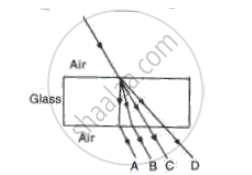Advertisements
Advertisements
प्रश्न
The diagram shows the path of a ray of light through a rectangular glass block placed in a liquid of uniform density.

(a) Does the light speed up or slow down in the glass,
(b) Give the reason for your answer.
उत्तर
(a) The speed of light, travelling from liquid to glass, slow down.
(b) Speed in liquids = `"Speed of light of air"/"Refractive index of liquid"=(3xx10^8)/"Refractive index of liquid"`
Speed of light in glass = `"Speed of light in air"/"Refractive index of glass"=(3xx10^8)/"Refractive index of glass"`
Since the refractive index in glass is usually higher than that of liquid, hence the speed of light in glass will be less.
APPEARS IN
संबंधित प्रश्न
Draw a ray diagram to show the refraction of a monochromatic ray through a prism when it suffers minimum deviation
Name one factor that affects the lateral displacement of light as it passes through a rectangular glass slab.
Name a prism required for obtaining a spectrum of Ultraviolet light.
A ray of light of wavelength 6600 Å suffer refraction from air to glass. Taking \[\ce{_a\mu_g = \frac{3}{2}}\], find the wavelength of light in glass.
A student has traced the path of a ray of light through a glass slab as follows. If you are asked to label 1, 2, 3 and 4, the correct sequencing of labeling ∠i, ∠e, ∠r and lateral displacement respectively is
(a) 2, 1, 3, 4
(b) 1, 2, 3, 4
(c) 1, 3, 2, 4
(d) 1, 3, 4, 2
In the fig. name the ray which represents the correct path of light while passing through a glass block.

Which colour of light travels fastest in any medium except air?
How does the deviation produced by a prism depend on the wavelength of incident light?
Choose the correct alternative and rewrite the following:
A glass slab is placed in the path of convergent light. The point of convergence of light
A ray of light PQ is incident normally on the hypotenuse of a right-angled prism ABC as shown in the diagram given below:

(i) Copy the diagram and complete the path of the ray PQ till it emerges from the prism.
(ii) What is the value of the angle of deviation of the ray?
(iii) Name an instrument where this action of the prism is used.
